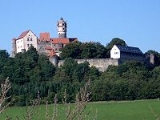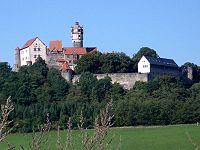
Ronneburg, Hesse
Encyclopedia
Ronneburg is both a castle and a municipality in the district of Main-Kinzig, in Hessen, Germany
. The town is most notable for being the site of Ronneburg castle.
cone, on top of which a castle
was built in the 13th century. Because of this, the area is called the "Ronneburger Hügelland," the "Ronneburg Hill Country." The castle, and the hill its sits on top of, can be seen in the town's coat of arms. The municipality consists of three villages: Neuwiedermuß (pop. 650), Altwiedermus (pop. 750), and Hüttengesäß (pop. 2200).
, which comprises several towns. On its southern side, Ronneburg borders the town of Langenselbold
, and in the west the town borders the municipality of Hammersbach.
 The castle and the surrounding town were first mentioned in a historical context in the year 1258, and other sources may refer to it as early as 1231. The castle's earlier names, Raneburg, and also Roneburg, likely derive from the old High German word "Rone," which means a fallen tree. This is likely a reference to the castle's attached palisades.
The castle and the surrounding town were first mentioned in a historical context in the year 1258, and other sources may refer to it as early as 1231. The castle's earlier names, Raneburg, and also Roneburg, likely derive from the old High German word "Rone," which means a fallen tree. This is likely a reference to the castle's attached palisades.
At the end of the 13th century, the castle was acquired by the Barons of Ysenberg-Büdingen, who were affiliated with the Hohenlohe family. One of the members of the Hohenlohe family, Gottfried III of Hohenlohe-Brauneck, sold the castle in 1313, to the archbishop of Mainz. The castle was mortgaged to the knight
s of Rockenburg, under whose influence the castle was expanded. Then, from 1339 until 1356, the castle was again a possession of the archbishopric of Mainz. During this time, several buildings at the castle were expanded, and a few new buildings were built as well. The castle was mortgaged again in 1424, this time to the count of Hanau.
In 1476, the archbishop of Mainz, Diether von Ysenburg, signed possession of the castle over to his brother, count Ludwig II of Ysenburg-Büdingen. After Ludwig died in 1511, his three sons fought over the castle for six years, until 1517. In 1523, the castle came into possession of Philipp von Ysenburg-Büdingen, and he founded the Ysenberg-Büdingen-Ronneburg family, later called simply the Ysingen-Ronneburg family. Under their rule, the castle took on its present-day form and layout. After the death of Heinrich Ysingen-Büdingen, the Ysingen-Büdingen line went extinct, and Wolfgang Ernst I von Ysenburg-Büdingen violently assumed ownership of the castle. In 1621, large parts of the castle were destroyed by a fire
, and thirteen years later, the castle suffered a major plundering at the hands of Croatia
n troops.
As the Ysenburg-Büdingen family were Calvinists, they allowed Protestant exiles to stay at the castle, and for a while, the castle was a haven for many other types of religious refugees, such as Jews
and Gypsies. In 1736 Nicolaus Ludwig Zinzendorf
took over the castle, and made it into a place of refuge for members of the Protestant Moravian Church. After two years, the castle could not accommodate the number of people who came to see it, and the Moravians founded another congregation, Herrnhaag
, on top of a nearby hill near Buedingen.
In June 2004 the castle was sold by Prince Wolfgang Ernst II von Ysenburg-Büdingen to baron Joachim Benedikt von Herman auf Wain, a nephew of princess Leonille von Ysenburg-Büdingen. It hosts a restaurant, a gift shop, and regular medieval festivals. Visitors may tour the castle on a daily basis. The tower provides excellent views of the Frankfurt skyline.
Germany
Germany , officially the Federal Republic of Germany , is a federal parliamentary republic in Europe. The country consists of 16 states while the capital and largest city is Berlin. Germany covers an area of 357,021 km2 and has a largely temperate seasonal climate...
. The town is most notable for being the site of Ronneburg castle.
Geography
The town is built near a steep basaltBasalt
Basalt is a common extrusive volcanic rock. It is usually grey to black and fine-grained due to rapid cooling of lava at the surface of a planet. It may be porphyritic containing larger crystals in a fine matrix, or vesicular, or frothy scoria. Unweathered basalt is black or grey...
cone, on top of which a castle
Castle
A castle is a type of fortified structure built in Europe and the Middle East during the Middle Ages by European nobility. Scholars debate the scope of the word castle, but usually consider it to be the private fortified residence of a lord or noble...
was built in the 13th century. Because of this, the area is called the "Ronneburger Hügelland," the "Ronneburg Hill Country." The castle, and the hill its sits on top of, can be seen in the town's coat of arms. The municipality consists of three villages: Neuwiedermuß (pop. 650), Altwiedermus (pop. 750), and Hüttengesäß (pop. 2200).
Neighboring cities
On the north, Ronneburg borders the city of Büdingen, and on the east, Ronneburg borders the municipality of GründauGründau
-Neighbouring places:Gründau is located near Gelnhausen and Büdingen. Frankfurt am Main, the largest city in Hessen, is located in a distance of about 50 km.-Division of the municipality:...
, which comprises several towns. On its southern side, Ronneburg borders the town of Langenselbold
Langenselbold
Langenselbold is a town in the Main-Kinzig district, in Hesse, Germany. It is situated on the river Kinzig, 10 km east of Hanau....
, and in the west the town borders the municipality of Hammersbach.
History of the villages
Hüttengesäß first appears in historical records during the 13th century under the control of the monastery of Sebold. In later times possession of Hüttengesäß passed with the castle. In 1643 Wiedermus suffered destruction at the same time the castle was sacked (see below) and was later rebuilt. The three villages have different endings to their names because in the past they had been divided among Prussia (Neuwiedermuß and Hüttengesäß) and the Grand Duchy of Hesse (Altwiedermus) which had different spelling conventions.History of the castle

At the end of the 13th century, the castle was acquired by the Barons of Ysenberg-Büdingen, who were affiliated with the Hohenlohe family. One of the members of the Hohenlohe family, Gottfried III of Hohenlohe-Brauneck, sold the castle in 1313, to the archbishop of Mainz. The castle was mortgaged to the knight
Knight
A knight was a member of a class of lower nobility in the High Middle Ages.By the Late Middle Ages, the rank had become associated with the ideals of chivalry, a code of conduct for the perfect courtly Christian warrior....
s of Rockenburg, under whose influence the castle was expanded. Then, from 1339 until 1356, the castle was again a possession of the archbishopric of Mainz. During this time, several buildings at the castle were expanded, and a few new buildings were built as well. The castle was mortgaged again in 1424, this time to the count of Hanau.
In 1476, the archbishop of Mainz, Diether von Ysenburg, signed possession of the castle over to his brother, count Ludwig II of Ysenburg-Büdingen. After Ludwig died in 1511, his three sons fought over the castle for six years, until 1517. In 1523, the castle came into possession of Philipp von Ysenburg-Büdingen, and he founded the Ysenberg-Büdingen-Ronneburg family, later called simply the Ysingen-Ronneburg family. Under their rule, the castle took on its present-day form and layout. After the death of Heinrich Ysingen-Büdingen, the Ysingen-Büdingen line went extinct, and Wolfgang Ernst I von Ysenburg-Büdingen violently assumed ownership of the castle. In 1621, large parts of the castle were destroyed by a fire
Fire
Fire is the rapid oxidation of a material in the chemical process of combustion, releasing heat, light, and various reaction products. Slower oxidative processes like rusting or digestion are not included by this definition....
, and thirteen years later, the castle suffered a major plundering at the hands of Croatia
Croatia
Croatia , officially the Republic of Croatia , is a unitary democratic parliamentary republic in Europe at the crossroads of the Mitteleuropa, the Balkans, and the Mediterranean. Its capital and largest city is Zagreb. The country is divided into 20 counties and the city of Zagreb. Croatia covers ...
n troops.
As the Ysenburg-Büdingen family were Calvinists, they allowed Protestant exiles to stay at the castle, and for a while, the castle was a haven for many other types of religious refugees, such as Jews
Judaism
Judaism ) is the "religion, philosophy, and way of life" of the Jewish people...
and Gypsies. In 1736 Nicolaus Ludwig Zinzendorf
Nicolaus Ludwig Zinzendorf
Nikolaus Ludwig von Zinzendorf und Pottendorf, Imperial Count of Zinzendorf and Pottendorf, , German religious and social reformer and bishop of the Moravian Church, was born at Dresden....
took over the castle, and made it into a place of refuge for members of the Protestant Moravian Church. After two years, the castle could not accommodate the number of people who came to see it, and the Moravians founded another congregation, Herrnhaag
Herrnhaag
Herrnhaag was a communal spiritual centre for the Moravian Unity, an early form of Protestantism. It and Marienborn, a nearby sister community, are located in the Wetterau, an area of Hesse, north of Frankfurt am Main in Germany....
, on top of a nearby hill near Buedingen.
In June 2004 the castle was sold by Prince Wolfgang Ernst II von Ysenburg-Büdingen to baron Joachim Benedikt von Herman auf Wain, a nephew of princess Leonille von Ysenburg-Büdingen. It hosts a restaurant, a gift shop, and regular medieval festivals. Visitors may tour the castle on a daily basis. The tower provides excellent views of the Frankfurt skyline.
Sites of interest
- The city features a middle-ages themed market, which is especially popular around ChristmasChristmasChristmas or Christmas Day is an annual holiday generally celebrated on December 25 by billions of people around the world. It is a Christian feast that commemorates the birth of Jesus Christ, liturgically closing the Advent season and initiating the season of Christmastide, which lasts twelve days...
time. - The castle features a museum, a restaurant, and a falconryFalconryFalconry is "the taking of wild quarry in its natural state and habitat by means of a trained raptor". There are two traditional terms used to describe a person involved in falconry: a falconer flies a falcon; an austringer flies a hawk or an eagle...
center. - A nearby museum features working Medieval catapults and other siege weapons.
- The basalt cones features many sites favorable for paragliding and other related activities.

